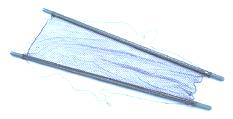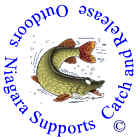|
THE PROPER HANDLING AND RELEASE OF
MUSKELLUNGE
Prepared by the Niagara Musky Association Inc.
Landing Methods: Net or Cradle.
Net:
-The rim of the net should he at least 30 inches wide.
-The net should be rubber coated and at least 40 inches deep.
-Lead the fish into net head first.
-Always keep a netted fish in the water.
-DO NOT bring a netted musky into the boat. A large musky thrashing
on the floor
of the boat can cause serious injuries to the fish and/or the
angler.
-Remove the hooks
Cradle
- Requires two people.
-Lead the fish into cradle head first.

-Close the cradle around the musky and hold securely.
-Keep the fish and cradle in the water.
-Remove the hooks (paragraph III).
-If you want to weigh the musky, do so in a cradle, net, or weigh sack
device which supports the frill length of the fish. Hanging a large fish
by the jaw may cause injuries to the jaw, skeletal vertebrae, and internal
organs and should be avoided.
-Length x girth x girth divided by 800 will give an accurate estimate of
the musky’s weight without the stress of weighing it.
Unhooking
- Take a moment to observe the situation while the fish is in the water
secured by the net or cradle.
-As long as the fish is in the water and allowed to breathe, it will be
ok.
-if necessary, you can secure a small musky by holding it tightly behind
its head, or by the tail, and a large musky by the gill plates (be careful
not to damage its gills, and beware of the gill rakers).
-Remove hooks using long-nose pliers or hook-out device.
-If hooks do not remove easily, cut them with hook or bolt cutters. Hooks
are plentiful and cheap, muskies are not. Remove hook remnants with
-If you don't have hook cutters, your hooks should be barbless.
Hooks on store bought lures can be made barbless by either pinching the
barbs in or filing them off.
-If the musky is deeply hooked, use jaw spreaders to keep mouth open to
enable you to reach in to remove hooks.
-Always exercise extreme care in unhooking and handling any musky. A hook
in the hand, leg or arm, or a hand tendon severed by a sharp tooth will
not only ruin a day's fishing, but can cause serious physical injury.
Measure fish
-Cradles have built-in length measurement, otherwise use a sixty inch the
stick.
-Lay stick next to fish while in it is in the water. Measure from the tip
of lower jaw to the tip of tail.
-If you desire, you can use a plastic tape measure to measure the girth at
the widest part of body. |

 |
Photograph fish.
-Photograph the fish while it is held in the water being resuscitated
for release.
-If you want to hold the fish out of the water, cradle one arm under its
belly while the other hand securely grips the gill cover. Always support
the full length of a large fish.
-Do not lift or hold the musky vertically. Fisheries biologists believe
that vertical lifts increase risk of injuring the jaw, skeletal vertebrae,
and internal organs.
-Try not to keep the fish out of the water for more than thirty-seconds.
The longer the musky is out of the water the greater the chances of
delayed mortality. Good rule: don't keep fish out of water any longer
than you can hold your breath.
-Photography can be tough on a muskellunge. Consider releasing most of
your muskies without taking out of water pictures.
-Warm waters of summer are especially tough on angler caught muskellunge.
Consider not removing the musky from the water during July and August.
Release Fish
-Hold the musky upright in water until it's able to swim away under
its own power. You may have to support the belly of larger fish to keep
them upright.
If you would like to learn more about catching and releasing
muskellunge, consider joining the Niagara Musky Association, Inc.
(top)
|
 Proper Release of Muskellunge
Proper Release of Muskellunge  Proper Release of Muskellunge
Proper Release of Muskellunge